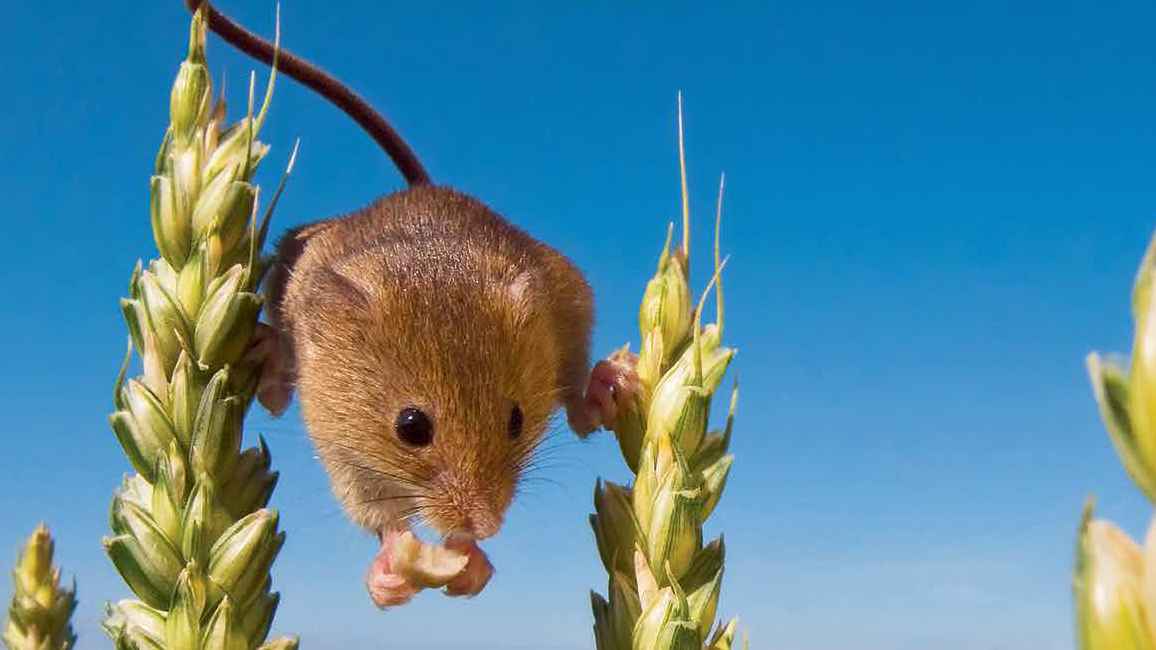
Harvest Mice
By Kathy Kranking; Photos by J-L Klein & M-L Hubert/Biosphoto/Minden PicturesHanging by your feet to eat? That’s no problem for the world’s most adorable acrobat!
It’s hard to say what a harvest mouse is better at—doing acrobatics or being cute. Actually it’s probably a tie.
Smaller than an adult’s thumb, a harvest mouse is the tiniest rodent in Europe, where these animals live. (They also live in parts of Asia.) In a contest for cuteness, they would win, paws down.
And then there are the gymnastics. Harvest mice climb grasses and reeds with the greatest of ease. They balance, dangle, and shimmy, hanging on with their super-small feet. They also get help from their talented tails, which curl around the stalks and hold on tight. The tails help them balance as well.
THE HIGH LIFE
Harvest mice live in the fields, meadows, marshes, and other places where there are tall plants, such as reeds and grasses, to climb. These plants are where the mice find their favorite foods—seeds, buds, and berries. But they’ll also look for food on the ground. And wherever they can find them, they’ll even eat insects.
Unlike some rodents, harvest mice don’t eat enough to cause damage to crops. So farmers don’t mind having these tiny gymnasts in their fields. The mice may even help farmers by eating insect pests.
WEE WEAVERS
Gymnastics aren’t the only thing harvest mice are good at. These mice are also talented at weaving! Using their mouths and paws, they weave tiny nests out of grasses. Some kinds of nests are for living in; others are just for spending a night in. And when a mama mouse is expecting babies, she makes a special nest for raising her young.
Here’s how she does it: First, she chooses a high spot between two stiff grass stems. Holding a blade of grass that’s still attached to the stalk in her front paws, she uses her teeth to tear it into strips. Then she weaves the strips into a loose ball, tucking and pulling them through each other. Once the ball has started to take shape, the mouse begins working from inside. She continues weaving, pulling blades of grass in from the outside. She also climbs other grass stems to nibble off blades to take back, shred into strips, and weave into the nest.
It can take two or three days to build the nest, which is about the size of a tennis ball when it’s finished. Mama Mouse then lines the nest with shredded grass. It’s all ready for the babies!
LITTLE ONES
Mama mouse gives birth to three to eight baby mice. The bright-pink newborns are blind and helpless. Their mother keeps them warm and nurses them with her milk. The tiny babies grow and change quickly. In little more than a week, they have fur and their eyes are open.
CROWDED HOUSE
The nest gets more crowded as the babies grow. But that’s OK, because they aren’t there for long. A harvest mouse’s “childhood” is pretty short. When the babies are a little more than two weeks old, they are ready to leave the nest and start their own lives. And just another month after that, they’ll be ready to mate and have babies of their own!
TROUBLES FOR MICE
In some places where they live, harvest mice are facing problems. Their numbers are going down because they are having trouble finding places to live. Farming methods have changed, and some farmers are cutting down hedges that used to divide their fields. Cutting the hedges gives the farmers room to plant more crops, but the mice have fewer places to live once the crops are harvested.
Without places to hide, the mice can be more easily caught by predators such as weasels, foxes, owls, and hawks. Pesticides used in the fields can also be bad for the mice.
HAVING A BALL
People are working hard to help harvest mice. But it’s not always easy to figure out if harvest mice are living in an area. One way is to find their old, abandoned nests. Another involves old tennis balls. Entrance holes are cut into the balls, and then the balls are mounted on poles and filled with seed. Later, if people find empty shells of the seeds along with mouse droppings inside the balls, they know harvest mice have been there. No other seed-eaters can fit into the tiny holes.
People have been breeding harvest mice in captivity and then releasing them in places where there are still lots of grasses that the mice need. And that’s good news. It means there will be even more little acrobats performing their “routines”—dangling, balancing, and scurrying their way among the grasses and reeds.
“Harvest Mice” originally appeared in the April 2014 issue of Ranger Rick magazine.
(Click on each image above for a closer view of the story.)



















